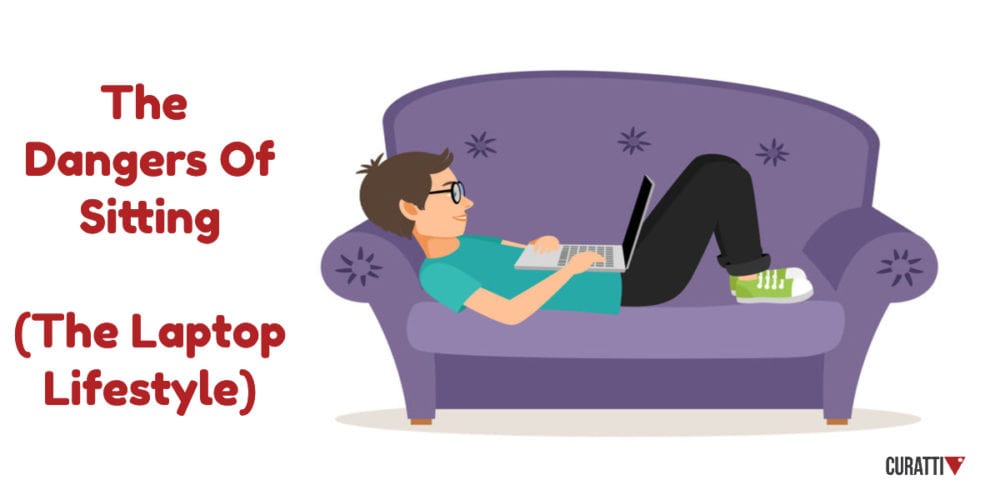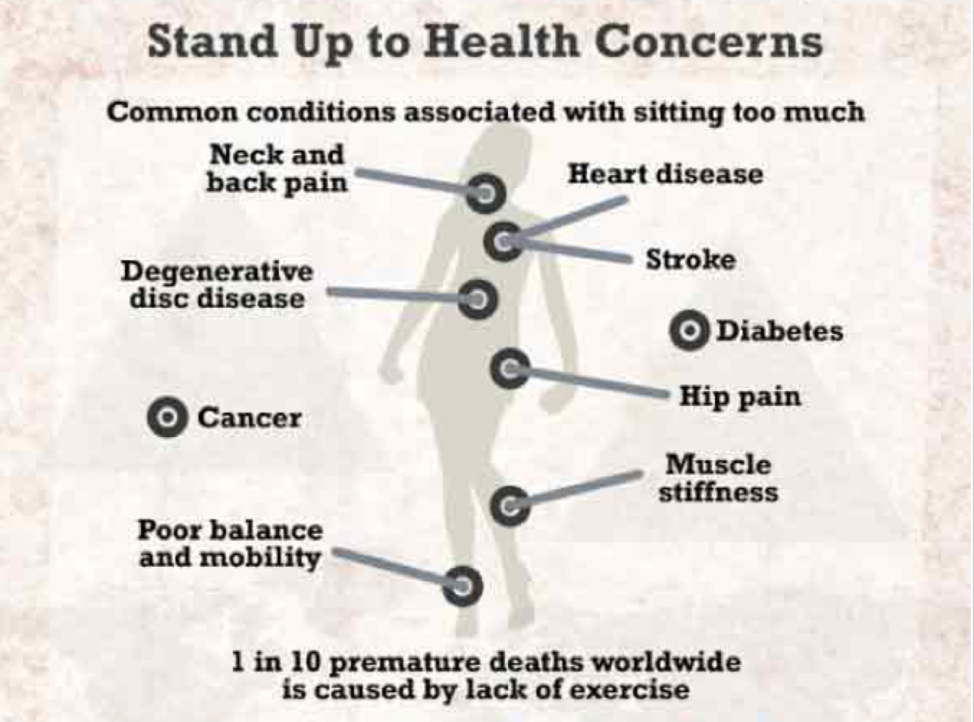The Dangers Of Sitting For Digital Marketers

As digital marketers, our bread and butter is making sure that our expertise shows in every campaign we launch or article we publish. Our ability to produce and disseminate quality content is our main line of offense in off-site SEO driving organic traffic to our products or services.
I’m a Los Angeles born and bred fitness freak and former English teacher. So transitioning careers into digital marketing at a startup that produces awesome club management software aligned perfectly with personal and professional passions. What more could I want in a career where I get to specialize in sneaking anchor text into fitness related blog posts?
The work itself has been everything I wanted and more. But the unexpected downside has been the physical impact of this career change. Transitioning from spending workdays running around a classroom convincing teenagers to care about To Kill A Mockingbird, to spending eight hours at a desk has affected me immensely.
And trust me, the irony that I work for a fitness-based company and have become significantly less active on a day-to-day basis is not lost on me!
To combat the inevitable backlash of 9-5 desk job immobility, here are small changes I have made to my everyday work routine. Collectively, these small steps keep my mind and body from entering levels of sluggish that no amount of caffeine can save.
Yes, Sitting all day is that bad for you
Just ask Google.

The expression “sitting is the new smoking” turns out to be only slightly hyperbolic. Data overwhelmingly supports how detrimental hunching behind a computer for extended periods can be both mentally and physically.
 Source: https://www.aha-now.com/sitting-killer-disease/
Source: https://www.aha-now.com/sitting-killer-disease/
On the physical side, scores of health problems are directly correlated with sitting.
Common diseases associated with inactivity are:
- Cancer
- Type 2 diabetes
- Osteoporosis
- High blood pressure.
But constantly sitting also inhibits circulation and oxygen flow necessary for our organs to properly function.
Furthermore, sitting is a counterintuitive position to our flexible and dynamic spines, which frame the makeup of our bodies. Poor posture contributes to fatigue, neck/jaw pain, and can even exacerbate autoimmune diseases like arthritis. This condition also can cause compression in our vertebrae and discs, which is a common cause of painful premature degeneration of the spine.
Our spinal cords are designed for standing and movement. But extensive sitting and slouching forces the structure into an unnatural position. Remaining stationary reduces blood flow throughout the body, including the brain, causing attention and alertness levels to decrease.
Slippery Slope: Desk-bound work to Sedentary lifestyle
As work routines manifest into habits, our bodies will adapt to new expectations of how to properly store and expel energy, making physical activity increasingly harder to commit to.
Even if individuals do perform regular exercise outside of work, these hours of activity, unfortunately, do not negate the impact that sitting for 8 hours a day exerts on our bodies. When sitting, our bodies’ fat burning capacities drop by 60%, stymying our metabolic work rate and making us more lethargic over time.
The physical effects of inactivity at work also tend to steamroll into other avenues of sedentary habits. For example, rather than prioritizing an hour of exercise a day, many will conclude their work days with leisure activities like watching television.
Stationary lifestyles diminish our exercise capacity, contributing to higher chances of obesity. The raw difference in mobility between desk jobs and jobs that require individuals to be on their feet is gigantic.
Physical Impact of Staring at your Monitor
 Source: https://share.upmc.com/2015/10/do-you-have-computer-vision-syndrome/
Source: https://share.upmc.com/2015/10/do-you-have-computer-vision-syndrome/
Physical problems manifest twofold: staring at a computer screen has also been proven to have an equally concerning backlash as prolonged sitting does. Computer Vision Syndrome became a legitimate medical term as the reliance on computers skyrocketed in the early 2000s.
How our eyes read and process material from screens affects us considerably more than printed text. Screen visuals are accompanied by contrasting backgrounds, layered text, and levels of exposure that force our eyes to constantly adapt. This continuous strain can result in blurred vision, eye irritation, neck and shoulder pain, or even long-term conditions like Glaucoma or chronic migraines.
Mental Distress and Anxiety
Work-related stress is far from uncommon, but what many do not realize is that a significant portion of this stress can be the result of inactivity. Mental health and physical activity are intrinsically linked. Serotonin levels are dependent on boosts from endorphins to maintain positive mental health.
Thus, prolonged sitting can affect mental health and contributes to anxiety, aggression, or depression. In the immortal words of Elle Woods, attorney at law:
 Source: https://tenor.com/view/legally-blonde-happy-bad-husband-endorphins-murder-gif-5614770
Source: https://tenor.com/view/legally-blonde-happy-bad-husband-endorphins-murder-gif-5614770
How to Break your Sitting Routine
1. Schedule Walking Breaks
Replacing smoke breaks with walking breaks at the workplace is becoming increasingly accepted and even encouraged. Countless studies corroborate how small walks, ideally outside, can substantially boost energy levels and productivity while reducing stress.
2. Prioritize In-Office Movement
 Whether it’s a walk to the water cooler, a coffee run, or even eating lunch in a different room, setting small breaks to get up and get your moving is incredibly important. As mentioned before, regularly exercising at the gym is great. However, that does not address the more serious problem of extended inactive periods.
Whether it’s a walk to the water cooler, a coffee run, or even eating lunch in a different room, setting small breaks to get up and get your moving is incredibly important. As mentioned before, regularly exercising at the gym is great. However, that does not address the more serious problem of extended inactive periods.
Therefore, reminding yourself to stand up and move frequently should not be ignored. I always make sure to get off one bus stop before my office so I can get an extra 10-minute walk in after my hour-long commute. And I always take the stairs instead of the elevator to and from the lobby. I also add a full lap around the office whenever I head to the kitchen for water or a snack.
3. Make independent exercise time a priority.
 We’re all busy; we’re all stressed; we’re all swamped. Building careers in any capacity behind computer screens is exhausting. With that said and understood, making time to take care of yourself is imperative.
We’re all busy; we’re all stressed; we’re all swamped. Building careers in any capacity behind computer screens is exhausting. With that said and understood, making time to take care of yourself is imperative.
Staying active and exercising does not necessarily mean that you need to become a gym rat. In this day and age, there is no shortage of options to get yourself moving. You can attend yoga classes, competing in Tough Mudder-style obstacle courses, or dancing off calories in Zumba.
Whatever you chose, make sure your exercise options are convenient and easy for you to access. After a long day at work, getting to the gym can feel 10x harder if it is not a convenient distance from either your home or workplace.
4. 20-20-20 Rule
To counteract the negative effects of screen vision, doctors recommend invoking what they term the 20-20-20 rule. This means that individuals are advised to take a 20 second break to view something 20 feet away every 20 minutes. This allows our eyes to relax as well as incites us to blink, which we often forget to do while processing information from screens.
Conclusion
You don’t need New Year to make resolutions. Consider addressing the evils of screen staring as one of them. Regardless of whether your desk job is in an office or a home, the dangers of sitting should not be taken lightly. Fortunately, small steps and additions to our routines can make all the difference for our long-term health.
You may also want to read: How to Blog Successfully and Stay Fresh While Working Full Time
 Laura is a Marketing Specialist for Perfect Gym Software. She is a native born Los Angeleno recently relocated to Warsaw, Poland who spends most of her time at the gym, on an airplane, or online shopping. You can tweet her @deeeeeebss
Laura is a Marketing Specialist for Perfect Gym Software. She is a native born Los Angeleno recently relocated to Warsaw, Poland who spends most of her time at the gym, on an airplane, or online shopping. You can tweet her @deeeeeebss
Featured image: Copyright: ‘https://www.123rf.com/profile_neyro2008‘ / 123RF Stock Photo
To receive more videos, in-depth articles and Infographics in your inbox, please sign up below

